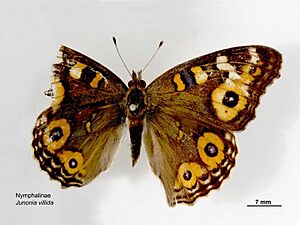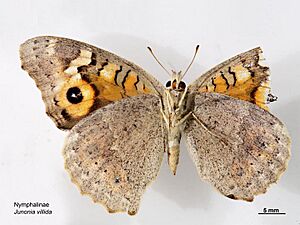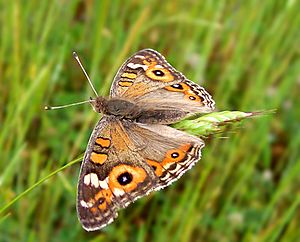Meadow argus facts for kids
Quick facts for kids Meadow argus |
|
|---|---|
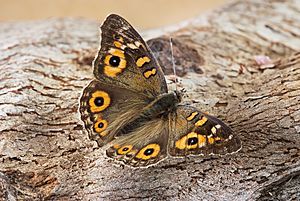 |
|
| Upperside of the wings | |
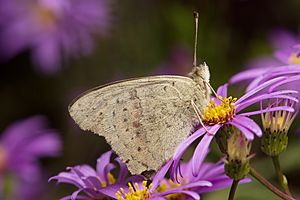 |
|
| Underside of the wings | |
| Scientific classification |
The meadow argus (Junonia villida) is a beautiful butterfly that belongs to the Nymphalidae family. You can often find it flying around in Australia. In the United Kingdom, it's sometimes called Albin's Hampstead eye, but it's usually only seen there if it accidentally travels from other places.
Contents
Discover the Meadow Argus Butterfly
The meadow argus butterfly has two brownish wings. Each wing has two special black and blue marks that look like eyespots. It also has white and orange marks along the edges of its wings.
These eyespots are super clever! They help the butterfly stay safe from animals that want to eat it. The eyespots can scare predators away or make them think the eyespot is the main target. This way, the butterfly might only lose a small part of its wing instead of its whole body.
The underside of the wings is mostly plain. However, the lower part of the front wing has similar marks to the top side. Male meadow argus butterflies have a wingspan of about 4 centimetres (1.6 inches). Females are slightly larger, with a wingspan of about 4.3 centimetres (1.7 inches).
When the butterfly rests, it can sit in four different ways, depending on what's happening around it:
- If the sun is shining, the butterfly will open its wings and relax.
- If there's danger in the sunlight, it will open its wings even wider. This shows off the eyespots on its back wings to scare off threats.
- If the sun isn't shining, the butterfly will close its wings.
- If danger comes when there's no sunlight, it will lift its front wings. This reveals hidden eyespots that were covered before.
Where the Meadow Argus Lives and Its Home
You can find the meadow argus butterfly mostly in mainland Australia. It also lives in places like Tasmania, Kangaroo Island, Lord Howe Island, and New Zealand. Other homes include Norfolk Island, Fiji, Papua New Guinea, Indonesia, Tuvalu, Samoa, and the Cook Islands.
These butterflies live in many different places. You might see them in cities, forests, woodlands, and open grasslands. They are not very common during the colder winter months. Every year, usually in October or November, these butterflies fly from southern Australia to warmer areas in the north. This journey is called migration.
The Life Cycle of the Meadow Argus
Meadow Argus Eggs
Meadow argus butterflies lay their eggs on the leaves of plants they like to eat. The eggs are shaped with strong vertical and horizontal lines. Usually, these tiny eggs hatch into larvae within 7 to 10 days.
Meadow Argus Larvae (Caterpillars)
Meadow argus larvae are black and have short, thin spines. These caterpillars enjoy munching on many different garden plants. They eat both plants that naturally grow there and ones that people have introduced. Some of their favorite plants include Plantago, plants from the Scrophulariaceae, Convolvulaceae, Compositae, Verbenaceae, Porulacaceae, and Gentianaceae families. This caterpillar stage lasts for about 4 to 5 weeks.
Meadow Argus Pupae
Meadow argus pupae can be many different colors. Most often, they are black with white and reddish-yellow dots. This stage, where the caterpillar changes into a butterfly, lasts for about 2 to 3 weeks.


